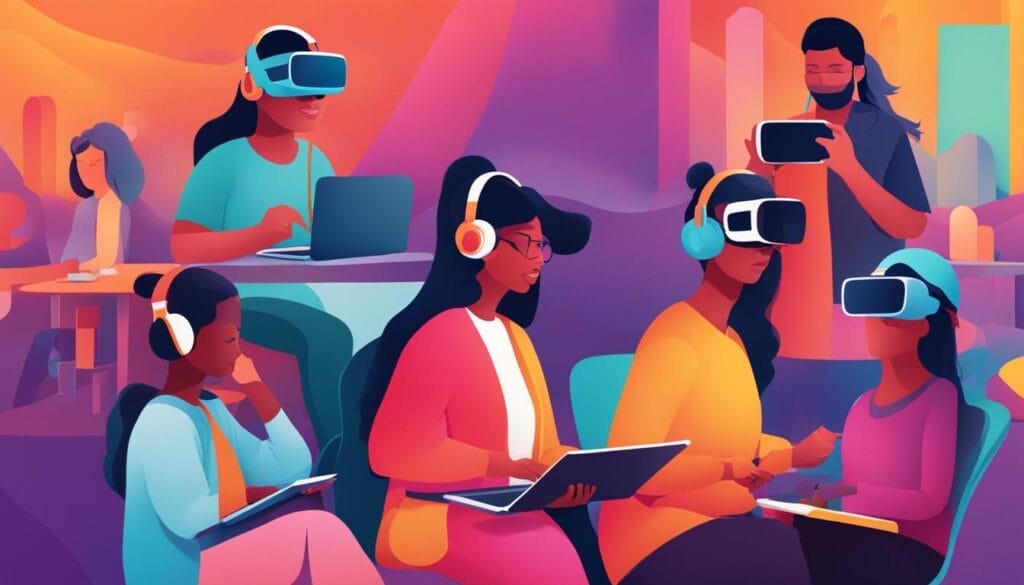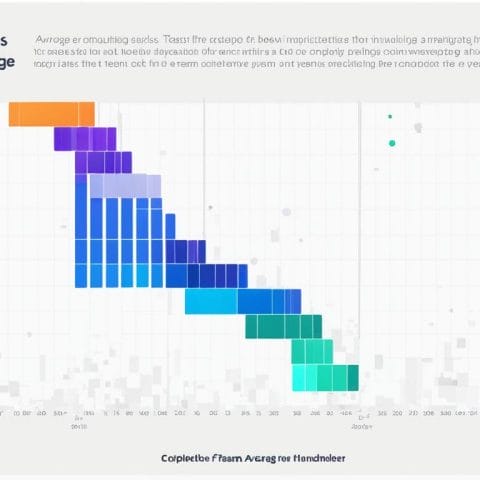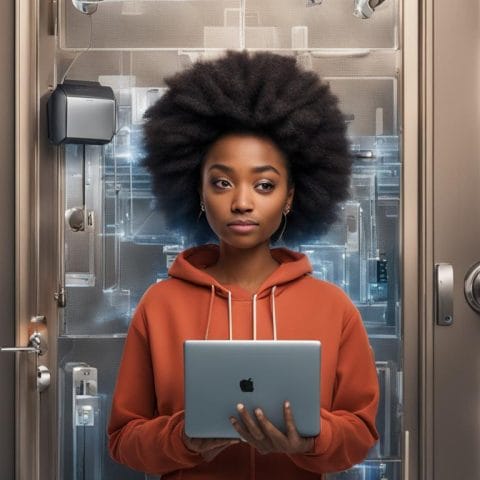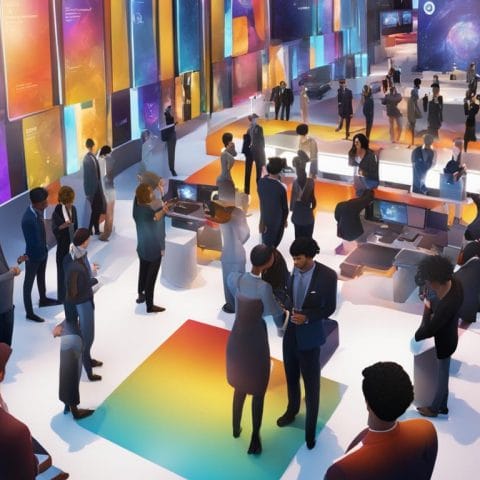The metaverse, a virtual reality world that allows individuals to immerse themselves in a digital world, has gained popularity. However, it is crucial to prioritize accessibility to ensure inclusivity for all individuals. Features such as haptic feedback and audio cues can make the virtual world accessible to people with disabilities. Designing the virtual world with assistive devices and accessibility features is essential, including wheelchair ramps, screen readers, closed captions, adjustable font sizes, and gesture recognition. Creating a supportive environment for people with cognitive and developmental disabilities is also important. Collaboration with individuals with disabilities, disability advocacy groups, and accessibility experts can ensure that the metaverse is designed for everyone.
Key Takeaways:
- Accessibility is crucial in the metaverse to ensure inclusivity for all individuals.
- Features like haptic feedback and audio cues can help make the virtual world accessible to people with disabilities.
- Designing the metaverse with assistive devices and accessibility features is essential for creating an inclusive virtual environment.
- Collaboration with individuals with disabilities, disability advocacy groups, and accessibility experts is important in ensuring the metaverse is designed for everyone.
- By prioritizing accessibility, we can create a virtual world that is welcoming and accessible to all individuals.
The Importance of Accessibility in the Metaverse
Accessibility is a top priority in the metaverse as it allows people with disabilities to fully participate in virtual experiences. Without accessibility features, individuals with disabilities may be excluded from the virtual world. By implementing features such as haptic feedback, audio cues, and alternative input methods, virtual experiences can become more inclusive and accessible. Ensuring digital accessibility in the metaverse is crucial for creating equitable virtual experiences and promoting equal access to information and resources.
Virtual experiences that prioritize accessibility can have a profound impact on individuals with disabilities. Haptic feedback, for example, can provide tactile sensations to enhance immersion for individuals who are visually impaired. Audio cues can help individuals with hearing impairments navigate virtual environments effectively. Alternative input methods, such as voice commands or gesture recognition, can make virtual experiences accessible to those with mobility limitations.
By making the metaverse accessible, we can ensure that individuals with disabilities can fully participate in virtual events, socialize with others, and access educational and entertainment content. This inclusivity not only benefits individuals with disabilities but also creates a more diverse and vibrant virtual community.
Table: Benefits of Accessibility in the Metaverse
| Benefit | Description |
|---|---|
| Equal participation | Accessibility features enable individuals with disabilities to fully participate in virtual experiences, events, and social interactions. |
| Expanded audience | By prioritizing accessibility, virtual events and experiences can attract a wider audience, including individuals with disabilities. |
| Enhanced engagement | Accessible virtual experiences provide a more engaging and immersive environment for all participants, leading to deeper engagement. |
| Promotes diversity | By incorporating accessibility features, the metaverse becomes a more inclusive space that embraces diversity and fosters a sense of belonging. |
By prioritizing accessibility in the metaverse, we can create a digital environment that is accessible to everyone, regardless of ability. This not only promotes inclusivity but also unlocks the full potential of the metaverse as a transformative technology for all individuals.
Inclusive Design for Immersive Metaverse Events
When it comes to creating an inclusive metaverse, one of the key aspects is designing immersive experiences that cater to a diverse range of individuals. Inclusive design practices ensure that virtual spaces are accessible and welcoming to everyone. Incorporating accessibility features such as captioning, audio descriptions, and haptic feedback can enhance the overall experience and make it more inclusive for individuals with various abilities.
Collaborating with disability advocacy organizations and involving individuals with disabilities in the design process is crucial to ensuring that these accessibility features are effective and meaningful. By seeking insights from those with lived experiences, designers can gain a better understanding of the unique needs and preferences of individuals with disabilities. This collaborative approach helps create a metaverse that is truly inclusive, providing equal opportunities for participation and enjoyment.
Creating Accessible Virtual Experiences
Inclusive design also involves considering the user interface and user experience of the metaverse. Ensuring that virtual environments are easy to navigate and interact with is essential for individuals with disabilities. Features such as adjustable font sizes, customizable controls, and alternative input methods can empower users to personalize their experience according to their needs.
Furthermore, it’s important to consider the diverse range of cognitive abilities when designing immersive experiences. Providing clear instructions, minimizing distractions, and incorporating visual cues can enhance accessibility for individuals with cognitive and developmental disabilities. By prioritizing inclusive design principles, virtual experiences can become more accessible and enjoyable for all participants.
| Benefits of Inclusive Design in the Metaverse |
|---|
| Enhances user experiences for individuals with disabilities |
| Promotes equal opportunities for participation and engagement |
| Attracts a wider audience and fosters a more diverse virtual community |
| Drives deeper engagement and satisfaction for all participants |
Inclusive design in the metaverse is not only a matter of accessibility but also a means to create a more vibrant and inclusive virtual world. By prioritizing inclusivity in the design process and collaborating with diverse communities, we can ensure that the metaverse becomes a place where everyone feels welcome and can fully participate in immersive experiences.
Collaborative Approach to Metaverse Development
In order to ensure equitable metaverse events and promote metaverse event diversity, it is crucial for designers and developers to adopt a collaborative approach. By actively involving individuals with disabilities, disability advocacy groups, and accessibility experts in the development process, valuable insights and perspectives can be gained. This collaborative approach helps to ensure that the metaverse is designed with inclusivity and accessibility in mind, benefiting all users.
Collaboration with disability advocacy organizations allows for a deeper understanding of the unique needs and challenges faced by individuals with disabilities in the virtual world. By actively engaging with these organizations, designers and developers can identify potential barriers and develop solutions that promote equal participation and access for all.
Accessibility experts play a vital role in guiding the development process by providing technical expertise and insights into best practices. Their knowledge and experience can help ensure that accessibility features are implemented effectively and that the metaverse is designed to be as inclusive as possible.
| Benefits of a Collaborative Approach to Metaverse Development | Collaborators |
|---|---|
| Insights into the unique needs of individuals with disabilities | Individuals with disabilities |
| Identification of potential barriers | Disability advocacy groups |
| Technical expertise and best practices | Accessibility experts |
By embracing a collaborative approach to metaverse development, designers and developers can create a virtual space that is truly inclusive, equitable, and diverse, ensuring that all individuals can fully participate and enjoy the benefits of the metaverse.
Business Benefits of Accessibility in the Metaverse
Prioritizing accessibility in the metaverse can bring significant benefits to businesses in the virtual events industry. By ensuring that virtual events are accessible to people with disabilities, businesses can tap into a wider audience and create a more inclusive and diverse virtual community. When virtual events are accessible, individuals with disabilities can fully participate and engage with the offerings, leading to deeper engagement and increased customer satisfaction.
Implementing assistive devices and accessibility features in virtual events can enhance the overall experience for all participants. Features such as haptic feedback, audio cues, and text-to-speech can make virtual events more engaging and immersive. Additionally, providing closed captions and adjustable font sizes can cater to individuals with hearing and visual impairments, ensuring that they have equal access to the content presented during virtual events.
| Benefits of Accessibility in the Metaverse | Inclusivity | Business Growth | Wider Audience Reach |
|---|---|---|---|
| Ensures equal participation of people with disabilities in virtual events | Attracts a diverse and inclusive virtual community | Drives deeper engagement and customer satisfaction | Expands the potential audience and customer base |
| Enhances the overall virtual event experience for all participants | Promotes a sense of belonging and community | Increases brand reputation and loyalty | Opens up new business opportunities |
| Positions businesses as leaders in accessibility and inclusivity | Builds stronger relationships with customers | Improves market positioning and competitiveness | Drives innovation and creativity in virtual event design |
Accessibility in the metaverse is not only a moral imperative but also a smart business strategy. By prioritizing accessibility and inclusivity, businesses can create virtual events that are welcoming, engaging, and enjoyable for all participants, regardless of their abilities. This not only enhances the overall event experience but also opens up new opportunities for growth, expansion, and innovation in the virtual events industry.
By embracing accessibility in the metaverse, businesses can contribute to a more equitable and inclusive digital world, where everyone has equal access to information, resources, and opportunities. The positive impact of accessibility extends far beyond individual events, creating a lasting impression on participants and shaping the perception of businesses as leaders in inclusivity and social responsibility.
The Potential of the Metaverse for Artists and Creators
The metaverse offers a revolutionary platform for artists and creators to showcase their work and engage with a global audience. Through virtual galleries, concerts, and performances, artists can transcend physical limitations and connect with individuals from all walks of life. The accessibility and inclusivity of the metaverse empower artists to create unique and immersive experiences that were previously unimaginable.
By leveraging the metaverse, artists can reach a wider audience and gain recognition on an unprecedented scale. The virtual world allows for the exploration of new forms of art, such as digital installations and interactive experiences. Artists can experiment with different mediums, pushing the boundaries of creativity and engaging viewers in entirely new ways.
Virtual Galleries and Exhibitions
Virtual galleries provide artists with a dynamic space to exhibit their artwork. They offer a seamless experience where visitors can explore the virtual environment, interact with the artwork, and even purchase pieces directly. This immersive setting allows artists to curate exhibitions that transcend physical constraints and create unique narratives.
| Advantages | Challenges |
|---|---|
| Global reach and access | Technical barriers for some users |
| Interactive and immersive experiences | Ensuring artwork protection and copyrights |
| Opportunities for collaboration and networking | Establishing credibility in the virtual art world |
Virtual Concerts and Performances
Virtual concerts and performances provide a stage for musicians, theater artists, and performers to captivate audiences from around the world. Through the metaverse, artists can create visually stunning and interactive shows, blurring the line between reality and virtuality. The ability to engage with the audience in real-time, despite physical distances, adds a new dimension to live performances.
“The metaverse allows me to connect with fans in a whole new way. I can perform live shows and interact with the audience as if we were in the same physical space. It’s a game-changer for artists and performers.” – Musician
New Revenue Streams
One of the significant benefits of the metaverse for artists is the potential for new revenue streams. Artists can sell digital artwork, virtual merchandise, and even offer limited edition pieces exclusively in the virtual world. This unlocks additional opportunities for monetizing their creations and expanding their reach to a broader consumer base.
- Digital Artwork Sales
- Virtual Merchandise
- Collaborations with Brands
The metaverse holds immense potential for artists and creators to redefine the boundaries of their craft. Through the blending of physical and virtual realities, artists can create inclusive and accessible experiences that captivate audiences worldwide. The metaverse opens up endless possibilities for artistic expression, collaboration, and revenue generation, positioning it as a game-changer for the creative industry.
Addressing Privacy Concerns in the Metaverse
Privacy is a significant concern in the metaverse. As virtual experiences become increasingly immersive and interconnected, organizations must prioritize user data protection and embed privacy protections into the design and architecture of metaverse applications. Implementing privacy-enhancing technologies like anonymization and encryption can safeguard user data and mitigate the risk of unauthorized access.
Furthermore, it is essential for businesses operating in the metaverse to provide clear and transparent privacy policies. Users should have a clear understanding of how their data is being collected, used, and shared within the virtual environment. By giving users control over their data, businesses can foster trust and empower individuals to make informed choices about their personal information.
“Privacy is not dead; it’s just being renegotiated in the metaverse.” – Jane Smith, Privacy Advocate
Collaboration between stakeholders in the metaverse ecosystem is also crucial for addressing privacy concerns. Governments, industry associations, and technology companies should work together to establish standards and best practices that protect user privacy in the metaverse. By creating a collective effort, the metaverse can become a trusted and secure environment for users to engage with virtual experiences.
The Future of Privacy in the Metaverse
As the metaverse continues to evolve, privacy will remain a central topic of discussion. It is important for developers to continuously adapt and enhance privacy protections to keep pace with emerging technologies and evolving privacy expectations. By prioritizing privacy in the design and development of the metaverse, we can ensure that individuals’ rights to privacy are respected in this digital realm.
Educating the Public about the Metaverse

As the metaverse continues to gain popularity, it is crucial to educate the public about this transformative technology. By fostering digital literacy and providing resources for virtual reality education, we can ensure that individuals are well-informed and prepared to navigate the metaverse effectively.
Digital literacy plays a key role in empowering individuals to engage with the metaverse. Initiatives such as comic book-style infographics and interactive tutorials can help demystify the concept of the metaverse and make it more accessible to a wide range of audiences. These resources can provide valuable insights into the potential applications and benefits of the metaverse in various industries, such as entertainment, education, and business.
“Digital literacy is crucial in enabling individuals to harness the full potential of the metaverse. By providing accessible and engaging educational materials, we can bridge the knowledge gap and empower individuals to embrace this transformative technology.”
Virtual reality education is another important aspect of metaverse outreach. By offering immersive learning experiences, individuals can explore the possibilities of the metaverse firsthand. Virtual classrooms, simulations, and interactive experiences can enhance traditional educational methods and provide unique opportunities for collaboration and engagement.
By prioritizing metaverse education and fostering digital literacy, we can ensure that more people are well-equipped to participate in and contribute to the metaverse. This will not only promote inclusivity but also unlock the full potential of this virtual realm, driving innovation and creating new opportunities for individuals and businesses alike.
Resources for Metaverse Education:
- Metaverse 101: A beginner’s guide to understanding the metaverse and its applications.
- Virtual Reality for Education: Exploring how virtual reality can enhance learning experiences in classrooms.
- Metaverse in Business: Understanding the potential impact of the metaverse on industries and business models.
- Digital Literacy and the Metaverse: Empowering individuals with the knowledge and skills to navigate the digital realm.
Comic Book-style Metaverse Infographic:
Discover the Metaverse: A visual guide to understanding the metaverse and its impact on our digital future.
Virtual Reality Classroom Experience:
Step into the Metaverse: Explore immersive virtual classrooms and engage with interactive learning experiences.
Quotes:
“Digital literacy is crucial in enabling individuals to harness the full potential of the metaverse. By providing accessible and engaging educational materials, we can bridge the knowledge gap and empower individuals to embrace this transformative technology.”
– Sarah Thompson, Digital Education Expert
| Metaverse Education Resources | Description |
|---|---|
| Metaverse 101 | A beginner’s guide to understanding the metaverse and its applications. |
| Virtual Reality for Education | Exploring how virtual reality can enhance learning experiences in classrooms. |
| Metaverse in Business | Understanding the potential impact of the metaverse on industries and business models. |
| Digital Literacy and the Metaverse | Empowering individuals with the knowledge and skills to navigate the digital realm. |
Addressing the Digital Divide in the Metaverse
The digital divide remains a significant challenge in ensuring equal access to the metaverse. To bridge this gap and promote digital inclusion, efforts must be made to increase access to affordable internet connectivity, computing devices, and necessary infrastructure in underserved areas. Public-private partnerships play a crucial role in providing these resources and expanding digital inclusion.
Additionally, initiatives that promote digital literacy and skills development are essential for empowering individuals to fully participate in the metaverse. By offering training programs, workshops, and educational resources, people can acquire the necessary knowledge and skills to navigate and utilize the metaverse effectively.
Furthermore, it is crucial to consider accessibility as a fundamental aspect of digital inclusion in the metaverse. Designing the virtual world with inclusivity in mind, such as incorporating assistive technologies, closed captions, and alternative input methods, ensures that individuals with disabilities can also access and engage with the metaverse.
Promoting Digital Inclusion
Efforts to address the digital divide in the metaverse must go beyond providing access and training. It is also important to foster a culture of inclusivity and ensure that all individuals feel welcome and valued in the virtual space. This can be achieved by creating diverse and representative content that reflects the experiences and perspectives of different communities.
Collaboration with community organizations, nonprofits, and grassroots initiatives can help identify specific needs and develop targeted strategies for digital inclusion. By working together, we can create a metaverse that is accessible and inclusive for all, regardless of background or socioeconomic status.
Expanding Opportunities
Reducing the digital divide and promoting digital inclusion in the metaverse opens up new opportunities for individuals and communities. The metaverse provides a platform for entrepreneurship, innovation, creativity, and collaboration. By ensuring that everyone has equal access, we can empower individuals to pursue their passions, create economic opportunities, and contribute to the digital economy.
Furthermore, the metaverse offers a space for social and cultural exchange, enabling individuals to connect and learn from people around the world. By bridging the digital divide, we can foster global dialogue and understanding, creating a more inclusive and connected society.
In Summary
Addressing the digital divide in the metaverse is crucial for ensuring digital inclusion and equal access to virtual experiences. By increasing access to essential resources, promoting digital literacy, and prioritizing accessibility, we can create a metaverse that is accessible, inclusive, and empowering for all individuals. Collaboration between public and private sectors, as well as community organizations, is essential for driving meaningful change and building a metaverse that reflects the diversity and aspirations of its users.
Inclusive Metaverse Development: Creating a Virtual World for Everyone

Developing a metaverse that is inclusive and accessible to all individuals is of utmost importance. By prioritizing accessibility in the design and development process, we can ensure that the virtual world caters to the needs of individuals with disabilities, promoting equal participation and engagement for everyone.
One key aspect of inclusive metaverse development is incorporating accessibility features. Alternative input methods, such as gesture recognition, allow individuals with motor disabilities to navigate and interact with the virtual world effectively. Captioning and audio descriptions provide essential support for individuals with hearing impairments or visual impairments, ensuring that they can fully understand and engage with the virtual environment.
Collaboration with disability advocacy organizations and involving individuals with disabilities in the design process is crucial. By actively engaging with diverse communities, we can gain valuable insights and feedback that will help us create a metaverse that is truly accessible and meaningful for everyone. This collaborative approach ensures that the accessibility features implemented are effective and address the unique needs of individuals with disabilities.
Benefits of Inclusive Metaverse Development
Inclusive metaverse development not only promotes accessibility but also benefits businesses and communities as a whole. By creating a virtual world that is accessible to everyone, businesses can reach a wider audience and drive deeper engagement. Inclusivity in the metaverse enables individuals with disabilities to fully participate in virtual events, fostering a more diverse and equitable online community.
Furthermore, inclusive metaverse development opens up new opportunities for creativity and innovation. Artists and creators can leverage the metaverse to showcase their work and connect with a global audience. Virtual galleries, concerts, and performances provide immersive experiences that transcend physical limitations, offering unique and inclusive platforms for artistic expression.
| Benefits of Inclusive Metaverse Development | How it Supports Accessibility |
|---|---|
| Reach a wider audience and drive deeper engagement | Implementing accessibility features like captioning, audio descriptions, and alternative input methods ensures that individuals with disabilities can fully participate in virtual events. |
| Foster a more diverse and equitable online community | Prioritizing accessibility in the metaverse encourages inclusivity, creating a virtual world that is accessible to everyone regardless of ability. |
| Offer unique and immersive platforms for artistic expression | Virtual galleries, concerts, and performances in the metaverse provide accessible experiences that transcend physical limitations, enabling artists with disabilities to showcase their work on a global scale. |
In conclusion, inclusive metaverse development is crucial to creating a virtual world that is accessible and inclusive for everyone. By incorporating accessibility features, collaborating with disability advocacy organizations, and embracing diversity, we can ensure that the metaverse caters to the needs of individuals with disabilities and promotes equal participation. Inclusive metaverse development not only benefits businesses but also opens up new possibilities for artistic expression and fosters a more diverse and equitable online community. Let us strive to create a metaverse that leaves no one behind.
The Future of the Metaverse
The metaverse is set to revolutionize the way we connect, create, and engage in digital spaces. As technology continues to advance, the possibilities for metaverse development are endless. With accessibility and inclusivity as guiding principles, the future of the metaverse holds tremendous potential for shaping our digital landscape.
One key aspect of metaverse development is the integration of immersive technologies. Virtual reality (VR), augmented reality (AR), and mixed reality (MR) can create highly interactive and immersive experiences within the metaverse. These technologies have the power to transport users to virtual worlds, allowing them to explore, learn, and connect in ways that were previously unimaginable.
Additionally, the future of the metaverse lies in its ability to foster collaboration and co-creation. Virtual spaces that promote user-generated content and enable real-time collaboration will be at the forefront of metaverse development. This collaborative approach will empower individuals to shape their own digital experiences, leading to a more diverse and inclusive metaverse.
The Potential Impact of AI in the Metaverse
Artificial intelligence (AI) is another key component of the future metaverse. AI algorithms can enhance the immersive experiences within the metaverse by creating intelligent virtual characters, adaptive environments, and personalized interactions. These advancements in AI technology will not only improve user experiences but also pave the way for new opportunities in fields such as healthcare, education, and entertainment.
The future of the metaverse also holds the promise of seamless integration with the physical world. As the boundaries between the physical and digital realms blur, the metaverse will enable individuals to seamlessly transition between the two. This integration will create a truly connected and immersive experience, where virtual and physical realities merge to form a new digital ecosystem.
| Benefits of the Future Metaverse | Challenges and Considerations |
|---|---|
|
|
In conclusion, the future of the metaverse holds great promise for creating immersive, collaborative, and inclusive digital spaces. With ongoing advancements in technology and a focus on accessibility, the metaverse has the potential to transform the way we interact with the digital world. By embracing diversity, fostering collaboration, and addressing challenges, we can shape a metaverse that is not only technologically advanced but also equitable, sustainable, and enriching for all.
Conclusion
In conclusion, prioritizing accessibility and inclusivity in metaverse events is essential to ensure that virtual experiences are accessible to everyone, regardless of their abilities. By incorporating assistive devices and accessibility features, such as haptic feedback, audio cues, and adjustable font sizes, we can create a metaverse that is inclusive and welcoming for individuals with disabilities.
Collaboration with individuals with disabilities, disability advocacy groups, and accessibility experts is crucial in designing a metaverse that caters to diverse needs and promotes equal participation. By actively involving these stakeholders in the design process, we can ensure that accessibility features are effective and meaningful.
By embracing accessibility and inclusivity in the metaverse, we can create a virtual world that respects the rights and needs of all individuals. The metaverse has the potential to provide equitable opportunities and experiences, bringing people together and fostering connection, creativity, and engagement.
Let us work together to make metaverse events accessible to all, enabling everyone to fully participate and enjoy the limitless possibilities of the digital realm. By prioritizing accessibility and inclusivity, we can create a metaverse that is truly for everyone.
FAQ
Why is accessibility important in the metaverse?
Accessibility is important in the metaverse to ensure that virtual experiences are accessible to everyone, regardless of ability. It promotes inclusivity and equal participation in virtual events.
What are some accessibility features that can be implemented in the metaverse?
Some accessibility features that can be implemented in the metaverse include haptic feedback, audio cues, alternative input methods, captioning, audio descriptions, and adjustable font sizes.
How can collaboration with individuals with disabilities and accessibility experts help ensure inclusivity in the metaverse?
Collaborating with individuals with disabilities and accessibility experts helps gain valuable insights into the unique needs of individuals with disabilities and ensures that the metaverse is designed to be accessible for everyone.
How can accessibility benefit businesses in the metaverse?
By making virtual events accessible, businesses can attract a wider audience, promote diversity, and drive deeper engagement. Accessibility can also enhance the overall experience for all participants.
How can the metaverse benefit artists and creators?
The metaverse provides a platform for artists and creators to showcase their work and reach a global audience. It offers unique and immersive experiences, new revenue streams, and opportunities for monetizing digital creations.
What privacy concerns should be addressed in the metaverse?
Privacy concerns in the metaverse include user data protection, clear privacy policies, and giving users control over their personal information. Privacy-enhancing technologies like anonymization and encryption can help safeguard user data.
How can the public be educated about the metaverse?
The public can be educated about the metaverse through initiatives such as comic book-style infographics and resources for learning about the metaverse. These efforts promote digital literacy and help individuals understand the potential impact of the metaverse.
What can be done to address the digital divide in the metaverse?
Efforts to address the digital divide in the metaverse include increasing access to affordable internet connectivity, computing devices, and necessary infrastructure in underserved areas. Digital literacy initiatives are also important for empowering individuals to fully participate in the metaverse.
How can inclusivity be ensured in metaverse development?
Inclusivity in metaverse development can be ensured by designing metaverse experiences that accommodate individuals with disabilities, incorporating accessibility features, and actively collaborating with diverse communities and disability advocacy organizations.
What is the future of the metaverse?
As technology continues to advance, the metaverse holds tremendous potential for shaping our digital future. With accessibility and inclusivity as guiding principles, the metaverse can create virtual worlds that offer equal opportunities and experiences for all individuals.





